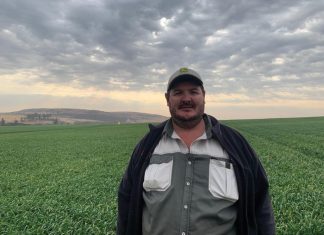
ARC-Institute for Agricul-tural Engineering
Soil health and productivity can be enhanced through well-drained soils. Artificial drainage in agriculture is a practice used to improve the natural drainage conditions and has been practiced worldwide for many years.
In South Africa artificial drainage was introduced in the late 50s and early 60s. Various approaches and techniques have been used and are still being used to drain agricultural fields.
Ecological farming is recognised as the objective of sustainable agriculture and includes all methods which regenerate ecosystem services such as the prevention of soil erosion; water infiltration and retention; carbon sequestration in the form of humus and increased biodiversity. Many techniques are used, including no till; multispecies cover crops; strip cropping; terrace cultivation and pasture cropping. Together with these, efficient irrigation and drainage are of utmost importance for improved soil health and productivity for sustainable agriculture.
Subsurface drainage of agricultural lands (Photo 1) is an instrument for production growth, a safeguard for sustainable investment in irrigation and a tool for conservation of land resources. There are, however, pressing needs for more investment in land-drainage systems to maintain current production levels in existing agricultural systems around the world and to drain degraded and abandoned agricultural lands.
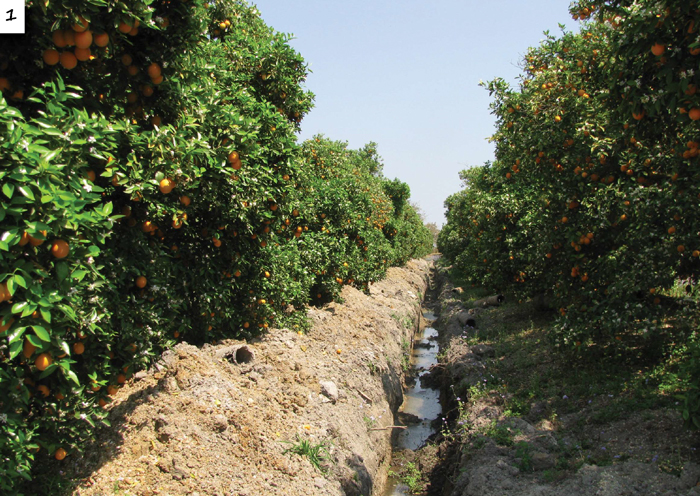
The extent of cultivated area worldwide is estimated at 1 500 million ha, out of which about 390 million ha are said to be provided with sustainable water management systems, being irrigation, drainage or both. It is estimated that 500 000 ha of the world’s total agricultural land are becoming unproductive every year due to poor drainage.
In South Africa 16 000 000 ha are cultivated of which 1 600 000 ha are registered for irrigation. It is estimated that 240 000 ha are affected by rising water tables and salinisation and the problems appear to be expanding. Subsurface drainage systems are installed on 65 000 ha and another 110 000 ha have surface drainage systems. There are many causes of drainage problems in South Africa, including the following:
- Inefficient and badly managed irrigation systems, especially where there are very shallow soils and insufficient natural drainage. This causes salts to accumulate and the end result is that the land has to be withdrawn from production.
- Leaking earthen dams and irrigation furrows (Photo 2).
- In some areas terraces are designed and established in order to obtain the right slopes for flood irrigation. Unfortunately, sooner or later drainage problems start to occur at the bottom of these terraces.
- Where natural waterways are being cultivated, wet conditions can be expected, which may lead to drainage problems (Photo 3 and Photo 4).
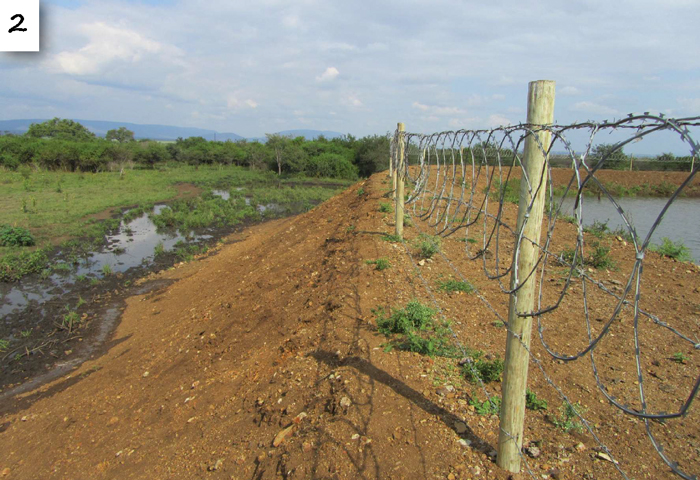
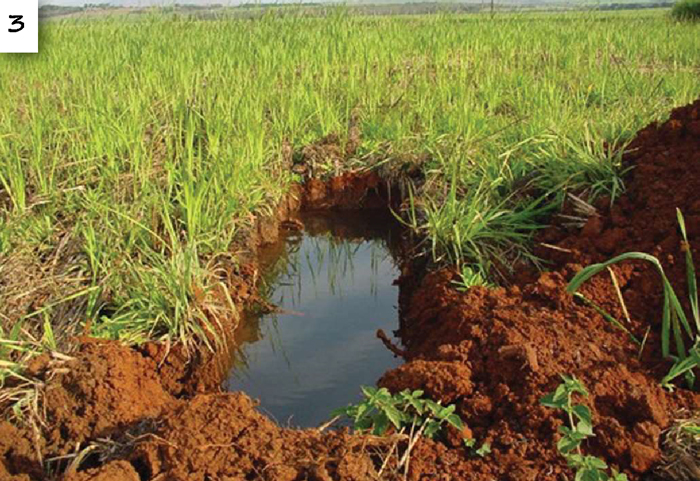
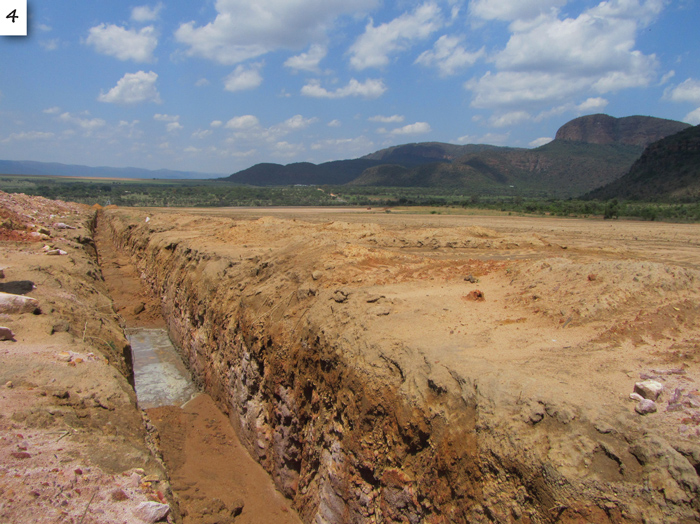
Subsurface drainage systems have proved to be an essential method to restore the productivity of agricultural lands, especially in arid and semi-arid zones. These agricultural subsurface drainage systems can be used for the following:
- Reclamation of new land with a groundwater table and/or soil salinity that are too high.
- Controlling groundwater levels at desired depths and soil salinity at desired levels.
- Restoring the productivity of waterlogged and/or salinised lands to their potential levels.
In many respects it is essential to have drainage with irrigation, with the following impacts:
- Initial high implementation cost.
- Lowering of the water table.
- Reducing soil compaction and destruction.
- Leaching of accumulated salts.
- Field operations without waterlogging.
- Extended growing season.
- Increased root development.
- Improved yields.
- Better drought resistance.
- Sustainable long-term irrigation.
The impact of irrigation without drainage are as follows:
- Non-effective irrigation application.
- Shallow root development.
- Field operations are more difficult.
- Greater control of weeds is required.
- Rise of the water table.
- Salt accumulation.
- Reduction in plant available water.
- Development of bad patches in the field.
- No or limited yield.
The need for subsurface drainage in irrigated lands cannot be over-emphasised as it is regarded as a sustainable and proven solution to both waterlogging and salinity problems. By correcting the water table status and the salinisation together with the installation of a proper erosion control system, soil health and crop production can be improved. It will also minimise the impact on the environment and improve the profitability of the producer.
All drainage works, small and large, have certain requirements and the following factors need to be taken into account:
- Identify the purpose of what is to be reached with the drainage works.
- Investigate all conditions and obtain design information in the field.
- Make use of previous information and experience of a similar area.
- Do a proper financial costing of the project.
The basic steps of developing a subsurface drainage system are the following:
- Investigate the problem and plan the system.
- Design a drainage system.
- Prepare work drawings and plans.
- Compile the specifications.
- Install the subsurface system.
- Maintain the system.
Typical layouts are shown in Figure 1 and depend on the specific circumstances and topography of the area. Select a drainage pattern that best fits the topography and the groundwater conditions.
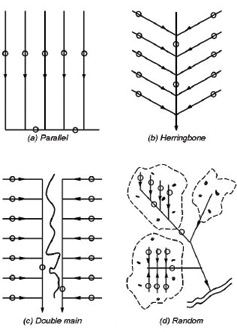
The herringbone system (b) consists of parallel laterals that enter the main at an angle, usually from both sides. This system is used for long, relatively narrow, wet areas. The parallel system (a) is similar to the herringbone system except that the laterals enter the main from only one side. This system is used on flat, regularly shaped fields with uniform soil types. The double-main system (c) is a modification of the parallel and herringbone systems. It is used where a depression, which is frequently a natural watercourse, divides the field. A random system (d) is used where the topography is undulating or rolling and contains isolated wet areas.
Installation can take place either manually (where trenches are dug and pipes are laid by hand) or mechanically as shown in Photo 5.
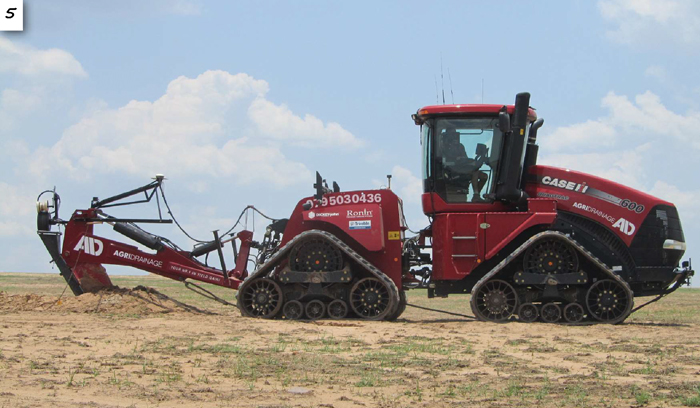
Since subsurface drainage is a high investment operation, a greater return from agricultural land is expected after installation of subsurface drains. It is of utmost importance that this investment is safe-guarded by regular maintenance.
Drainage systems are man-made systems that are only implemented when natural drainage is insufficient for a satisfactory form of agriculture. It is necessary to consider technical, economic and environmental issues when a project of this nature is embarked on.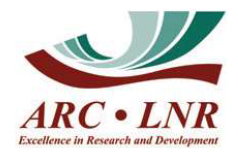
In many cases it is advisable to get expert advice to assist with subsurface drainage projects. In this regard the ARC-Institute for Agricultural Engineering has completed a project, Development of technical and financial norms and standards for drainage of irrigated lands, that has been published by the Water Research Commission. It provides guidelines for the planning and design of subsurface drainage that will provide efficient drainage for improved and sustainable soil health.










